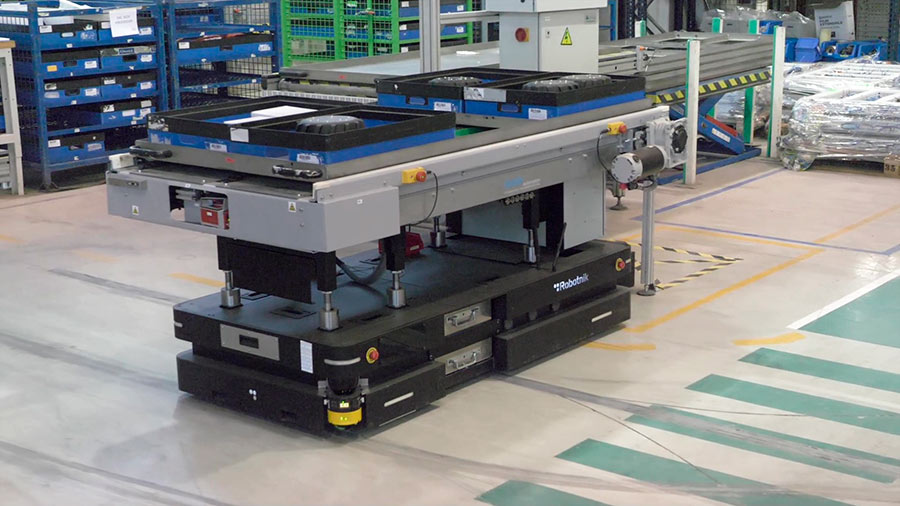In an increasingly high-pressure supply chain, mobile robotics for the transport of goods in warehouses represent an optimal solution for logistical efficiency.
In a global, connected, demanding and fast-moving market, traditional logistics solutions are no longer sufficient to stay competitive.
Did you know that one of the most time-consuming logistics tasks is the transportation of materials and loads?
As Robotnik’s guide to logistics automation shows, to address this scenario, warehouse management must be agile, flexible and profitable. The automation of transportation in the warehouse is one of the keys to achieving this efficiency.

Download here the guide to logistics automation
Autonomous mobile robots work collaboratively with operators carrying out routine tasks of transferring materials within the same warehouse or between different facilities. Thus, they have become an invaluable tool to optimize logistics processes, accelerate workflow, reduce production costs and avoid dangerous or tedious tasks for workers.
Find below the 3 reasons why autonomous mobile robots have already established themselves as the main tool to improve warehouse processes.
1. MOBILE ROBOTS IN WAREHOUSES: REDUCING DOWNTIME
One of the main benefits of mobile robots in warehouse management is the significant reduction in downtime. Robots can operate continuously, minimising downtime and maximising productive time. Mobile robots are designed to perform repetitive tasks uninterruptedly, ensuring a constant flow of goods within the warehouse.
2. MOBILE ROBOTS IN WAREHOUSES: REDUCING OPERATING COSTS
Many logistics companies are currently facing significant labour shortages. This fact, coupled with the growing demand for e-commerce, makes real, intelligent automation of warehouse operations more necessary than ever. Traditional logistics methods are not only slower but also less cost-effective. The implementation of mobile robots leads to a significant reduction of labour costs for different reasons:
- They make up for the lack of skilled labour.
- They operate uninterruptedly
- Speed up mechanical and repetitive tasks
- They avoid human error
- They do not require prior modification of the infrastructure
3. MOBILE ROBOTS IN WAREHOUSES: IMPROVEMENTS IN LOGISTICS EFFICIENCY
The use of autonomous mobile robots directly brings improvements in warehouse processes and logistics efficiency in general.
- Versatility of AMRs: Mobile robots are highly versatile and can adapt to a wide variety of tasks within the warehouse: from transporting goods to inventory management. This flexibility allows companies to quickly adjust their operations in response to changes in demand or internal processes.
- AMR Scalability: As a company grows, so does the complexity of its logistics operations. Mobile robots offer a scalable solution, allowing companies to increase their transportation capacity without needing to significantly expand their infrastructure. Adding more robots to the existing fleet is a relatively simple process, making it easy to expand operations in line with business growth.
- Robotics Precision: Real logistics efficiency requires a high level of precision. Errors in inventory management, for example, lead to delays that result in financial losses. The same applies to the supply of materials on a production line: operators waste a large part of their time transporting material from one point in the warehouse to another. AMRs allow precise, real-time monitoring of stocks, reducing human errors and sparing workers this physical wear and tear.
WHAT MATERIAL TRANSPORT TASKS CAN MOBILE ROBOTS PERFORM?
These are some examples of the tasks that can be automated in a logistics centre, through the implementation of mobile robots:
- Shelf Replenishment: An AMR can pick products from receiving areas and transport them to storage shelves, ensuring products are correctly placed for later pick-up.
- Package returns: returning merchandise is a very common process in any warehouse, especially in the ecommerce sector. A mobile robot automates the transportation of returned merchandise from the designated area to the inspection point, sorting and subsequent reintegration into inventory.
- Transport of heavy loads: The transport of heavy materials poses a serious danger to the safety of the operators. The AMR RB-ROBOUT has the capacity to move loads weighing up to 1 ton between different locations.
- Inventory Management: Among warehouse operations, inventory management is one of the most critical tasks. Autonomous mobile robots are capable of scanning QR codes or RFID tags to monitor inventory information in real time. In this way, updated information on stock levels is obtained, avoiding failures due to loss of products or outdated inventory.
WHAT IS THE FUTURE OF MOBILE ROBOTS FOR TRANSPORTING GOODS IN WAREHOUSES?
In the midst of the scenario known as logistics 4.0, autonomous mobile robotics marks a fundamental transformation for the optimization of the supply chain. Logistics workflows related to the transportation of materials are repetitive, necessary tasks that do not add any value to the majority of operators.
The automation of logistics processes ultimately pursues the objective of providing logistics companies with new levels of operational competence by reducing costs, improving customer satisfaction and stable growth.
The future of mobile robots in warehouse transportation management is advancing, driven by continuous technological advances such as the Internet of Things (IoT), big data analysis, artificial intelligence (AI) or Deep Learning. These innovations improve the ability and autonomy of robots like the RB-THERON to perform more complex tasks and adapt to changing environments.
One of the main challenges remains the democratisation of mobile robotics for warehouses. Robotnik works to make this technology available not only to large logistics companies, but also to SMEs.



